.
Griechische Architektur, Tempel: Die Dorische, Ionische und Korinthische Bauart
Once upon a time trees were temples of the deities,
and in conformity with primitive ritual simple country places
even now dedicate a tree of exceptional height to a god;
nor do we pay greater worship to images shining with gold and ivory
than to the forests and to the very silences that they contain.
Pliny, Natural History, XII.2
Der griechische Tempel ist eigentlich kein Gebäude, sondern ein Monolithendenkmal in der Art der Cromlechs. Deshalb ist auch seine Bedachung, insbesondere die Giebelgestaltung, eine primitive und schwache Lösung. Die obligatorische plastische Giebelfüllung mitsamt dem falschen Gebälk ist, architektonisch betrachtet, eine Monstrosität. Walther Rathenau (German Politician). My translation: The Greek temple is actually not a building, but a monolith monument in the kind of the Cromlechs (a neolithic group of stones consisting of one large flat stone supported by several vertical ones). Therefore also its roof covering, in particular the Pediments composition, is a primitive and weak solution. The mandatory plastic Pediment coverage with the wrong timber work is architecturally regarded, a monstrosity.
Temple from Templum is the same word as the Greek temenos, from temnw to cut off, means to separate some special place from the rest of the land. Usually religion rites were held outside the temple in front of the temple at an altar. With a few exceptions (for example temple to Apollo on Delos) most temples face east as the priests faced the direction of the rising sun when making offerings to the gods.
A shrine is stronger than a tower to save, A shield that none may cleave. Aeschylus The Suppliants
Persons were protected in the sacred space of the Temenos, they could not be taken out without their will. They enjoyed the right of asylia (or today asylum, from sylan "to steal", ) (the right not to be taken or stolen out).

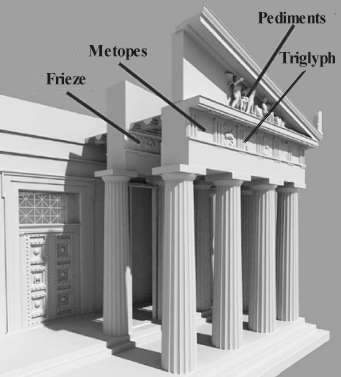
Doric Temples
Greek Doric temples have usually a pattern under the pediment known as triglyphs (three cuttings) and metopes. The triglyphs alternate with the metopes across the front of the temple. Triglyphs have three parts, and then in between the triglyphs are the metopes. The frieze often was an alternating set of triglyphs and metopes.
The Doric and Ionic Order are the main structural systems of Greeks temples (type of column, decoration, etc). The third so-called Corinthian Order is similar to the Ionic Order with differences mainly in the column decoration.
See:
The design of Temples depends on symmetry, the rules of which Architects should be most careful to observe. Symmetry arises from proportion, which the Greeks call analogia. Proportion is a due adjustment of the size of the different parts to each other and to the whole; on this proper adjustment symmetry depends. Hence no building can be said to be well designed which wants symmetry and proportion. In truth they are as necessary to the beauty of a building as to that of a well formed human figure... Vitruvius, de Architectura

Pronaos: The entrance-hall (porch) to the temple proper or cella
Naos (Cella in Roman ): usually the larger of the interior rooms, housed the cult statue.
Opisthodomos. Porch at the rear of the Naos, sometimes also a back entrance.
Adyton: Used as a treasury, a place limited to priest or priestesses.
Stereobate: The foundation of the temple, the upper part of which as a platform or foundation of the row of columns is called the Stylobate.
(stereo (solid), bates (walker), stylos (column)
Some basic versions of Temples
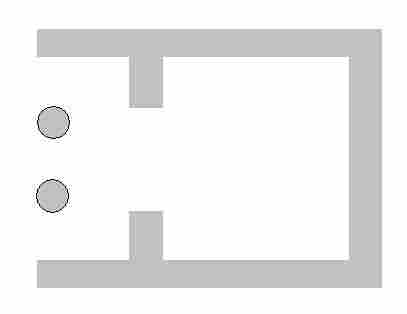
distyle Temple “distyle in antis” . From di (two), stylos (column) and antis the region defined by the two forward extensions of the sidewalls (Antae) of the Naos. Other versions tetrastyle in antis for the case of 4 columns between the antae.

Double Anta Temple
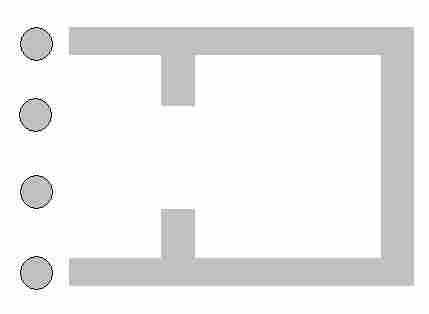
A prostyle Temple, with a colonnaded porch in front of the cella. A amphiprostyle Temple (amphi ,”both sides”) in case of another colonnaded porch in the rear side.
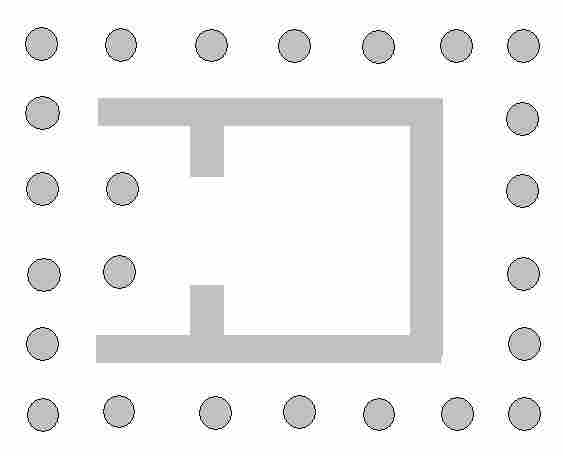
Peripteral Temple version (Naos surrounded from all sides by a row of columns) (example: Parthenon), or by a double row of columns (dipteral version) (example: Artemis Temple at Ephesus)
Older Temples also had an internal row of columns (colonnade)
The only way to judge of the treasures the Old Masters of whatever age have left us—whether in architecture, sculpture, or painting—with any hope of sound deduction, is to look at the work and ask oneself—"What was that like when it was new?" The Elgin Marbles are allowed by common consent to be the perfection of art. But how much of our feeling of reverence is inspired by time? Imagine the Parthenon as it must have looked with the frieze of the mighty Phidias fresh from the chisel. Could one behold it in all its pristine beauty and splendour we should see a white marble building, blinding in the dazzling brightness of a southern sun, the figures of the exquisite frieze in all probability painted—there is more than a suspicion of that—and the whole standing out against the intense blue sky; and many of us, I venture to think, would cry at once, Millais.
According to the number of columns in the front side: Tetrastyle, Hexastyle, Octastyle, Dekastyle for 4, 6, 8 or 10 columns respectively. Example: The Parthenon, a Octastyle Peripteral version, the Artemis Temple of Ephesus (Dekastyle). An unusual version the Enneastyle "Basilica" Templeof Paestum/Poseidonia (9 columns)
Other Temple versions: Tholos, a temple with a circular ground plan. (See Epidaurus Tholos , Decoration elements )
Temples were not only build for religious purposes.
They were used as treasuries, and also sometimes as a record office for example registering the names of all public debtors (the expression of "registered upon the Acropolis" eggegrammenoi en Akropoli for example means a public debtor).
From the sixth century BC onwards, various communities started to dedicate treasury houses (thesauroi) at Pan-Hellenic sanctuaries like Olympia and Delphi. These buildings were usually in the form of small temples such as the Siphnian Treasury.
Arhitekton originally signified a master carpenter. It was attributed not only to ship-builders who were responsible for the construction of the Greek triremes, or to the later ’master craftsman’ of a temple; but all sorts of craftsmen working with wood, Ömür Harmansah Archaic Age and the Metamorphoses of Greek Culture
VITRUVIUS, BOOK III, CHAPTER 2 On the kinds of temples
Temples and Monuments
|
Place |
Monument |
|---|---|
|
Temple of Aphaia 490 BC, Virtual Tour |
|
|
Argive Heraion (Sanctuary of Hera) “Above this temple are the foundations of the earlier temple and such parts of it as were spared by the flames. It was burnt down because sleep overpowered Chryseis, the priestess of Hera, when the lamp before the wreaths set fire to them.” Pausanias |
|
|
For the dimensions of the Parthenon I have the following numbers: W = 30.88 m , L = 69.5 m and H = 13.72 m.The Parthenon is a relatively small Temple (The Zeus Temple of Agrigent was much larger; L = 110 m, W= 55 m) Temple of Athena Nike, 427-424 BC , PLAN Hephaistos Temple (Theseion or Hephaisteion), 5th century BC Image |
|
|
Temple of Apollo Epikouros (Epicurius), 450-425 BC, PLAN (another plan), Naos Reconstruction ,6 *15 columns, Doric peripteral , discovered in 1765; sculptures taken to British Museum Virtual Reality Tour (Quick-time movie) World Cultural Heritage: Temple of Apollo Epicurius at Bassae (1986)
|
|
|
|
Temple of Apollo c. 540 BC Virtual Tour including other Temples (Poseidon, Herakles, Apollo, Hera Akraia, Hermes ...)
|
|
|
Sanctuary of Athena Pronaia (Reconstruction), Tholos Temple Apollo Temple (Image) Athenian Treasury , (another Image) (3D computer model) Sikyonian Treasury, Siphnian Treasury ... (Plan) (Frieze) (Perseus Info) , Reconstruction |
|
Apollo Temple, Virtual Tour and Links with Information |
|
|
Temple of Artemis, Original 550 BC |
|
|
Temple of Asklepios “The Epidaurians have a theatre in their sanctuary that seems to me particularly worth a visit” Pausanias Virtual Tour of other Epidauros monuments (Temple of Themis, Artemis, etc) |
|
|
Temple of Apollo Daphnephoros, end of 6th century BC destroyed by Persians 490 BC |
|
|
Mausoleum, 353-351 BC |
|
|
Acropolis |
|
|
Temple of Zeus |
|
|
Temple of Zeus, c. 470 - 456 BC, 6 * 13 columns, Doric peripteral, PLAN |
|
|
Temple of Hera I , c. 550 BC Temple of Hera II , c. 460 BC , Computer Reconstruction |
|
|
Temple of Hera (Heraion), 750 BC, first temple with surrounded colonnade |
|
|
Temple C (Perseus Info ) Severe Temple of Hera or Temple E PLAN |
|
|
Temple of Poseidon and Temple of Athena, Info , Virtual Tour On the Greek mainland facing the Cyclades Islands and the Aegean Sea the Sunium promontory stands out from the Attic land. When you have rounded the promontory you see a harbor and a temple to Athena of Sunium on the peak of the promontory. Pausanias Description of Greece, Book I, Attica |
|
|
Thermon (Aetolia) |
Apollo Thermios Temple 630-610 BC , Plan, Info , Reconstruction of the entablature (Terracotta decoration) |
|
Trysa |
Heroon |
|
Harpy Tomb, 480/470 BC Nereid Monument, 380 BC |
|
|
|
|
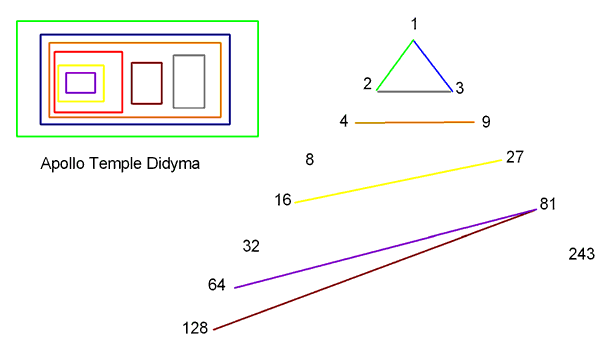
Apollo Temple in Didyma, the size of various elements are expressed by ratios of integer numbers from Platonic Pythagorean ideas
Ancient Greek Buildings and Architects
|
Building, City plan |
Architects |
|---|---|
|
Ictinus and Callicrates |
|
|
Nike’s Temple on the Acropolis (c. 420 BC) |
Callicrates |
|
Zeus Temple Olympia c. 470 - 456 BC |
Libon of Elis |
|
Fourth Temple of Hera, Samos (575-550 BC) |
Rhoikos of Samos |
|
Archilochos and Philocles or maybe Mnesicles |
|
|
Propylaea (437-432 BC) |
Mnesicles |
|
Temple of Apollo Epikouros, 450-425 BC, Bassae |
Ictinus |
|
Andronikos of Kyrrhos (or Cyrrhestes) |
|
|
Artemis Temple in Ephesus 550 BC destroyed by Herostratos 356 BC the birthday of Alexander the Great. Rebuilt 340-250 BC |
Chersiphron, Cretan architect of the original archaic Ionic temple. Chersiphron and his son Metagenes were said to be coauthors of a treatise on architectural engineering Demetrius and Paeonius (after the fire destruction) |
|
Temple of Alea Athena in the periods (375-350) or (350-325 BC) |
Skopas |
|
Mausoleum of Halicarnassus 353 - 351 BC
|
Pythius (or Pytheos), Decorated with sculptures of Scopas, Bryaxis, Leochares, and Timotheus. |
|
Apollo Temple, Didyma near Miletus (c. 310 BC) |
Paeonis and Daphnis |
|
Great Hall of the Mysteries at Eleusis The sanctuary of the mysteries at Eleusis
|
Philon Coroebus began to build the sanctuary he planted the columns on the floor and yoked their capitals together with architraves After his death Metagenes, of the deme Xypete, carried up the frieze and the upper tier of columns Xenocles, of the deme Cholargus, set on high the lantern over the shrine
|
|
Walls and the fort on the neck of the acropolis of Selinus in Sicily (408 BC) |
Hermocrates the son of Hermon (defender of Selinus) |
|
Smyrna city plan Alexander the Great conceived the idea of restoring Smyrna a work according to Strabo carried out under Antigonus (316–- 301 BC) and Lysimachus, who enlarged and fortified the city (301– - 281 BC). |
? |
|
Theater in Epidaurus (Virtual Tour) |
Polyclitus (The Sculptor) |
|
Sostratos the son of Dexiphanes, the Cnidian |
|
|
Chares |
|
|
Design of harbor Town of Piraeus, Miletus city plan |
Hippodamus (or Hippodamos) of Miletus the son of Euryphon (c. 498 - 408 BC) |
|
The Column of Trajan, Basilica Ulpia |
Apollodorus of Damascus, Greek engineer and architect, late first to early 2nd century AD, who worked mainly for the Roman emperor Trajan ( 98–- 117 AD). |
Greek Temples in Akragas (Agrigentum), Sicily
On this account Pythius, one of the ancients, architect of the noble temple of Minerva at Priene, says, in his commentaries, that an architect should have that perfect knowledge of each art and science which is not even acquired by the professors of any one in particular, who have had every opportunity of improving themselves in it. This, however, cannot be necessary; for how can it be expected that an architect should equal Aristarchus as a grammarian, yet should he not be ignorant of grammar. In music, though it be evident he need not equal Aristoxenus, yet he should know something of it. Though he need not excel, as Apelles, in painting, nor as Myron or Polycletus, in sculpture, yet he should have attained some proficiency in these arts. So, in the science of medicine, it is not required that he should equal Hippocrates. Thus also, in other sciences, it is not important that pre-eminence in each be gained, but he must not, however, be ignorant of the general principles of each. Vitruvius, de Architectura
Curiosities
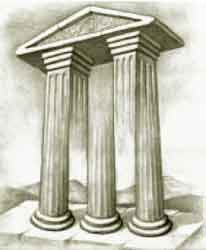
Are the columns rectangular? Are there two or three columns? © Sandro Del-Prete.
| Ancient Greece
Science, Technology , Medicine , Warfare, , Biographies , Life , Cities/Places/Maps , Arts , Literature , Philosophy ,Olympics, Mythology , History , Images Medieval Greece / Byzantine Empire Science, Technology, Arts, , Warfare , Literature, Biographies, Icons, History Modern Greece Cities, Islands, Regions, Fauna/Flora ,Biographies , History , Warfare, Science/Technology, Literature, Music , Arts , Film/Actors , Sport , Fashion --- |
Retrieved from "http://en.wikipedia.org/"
All text is available under the terms of the GNU Free Documentation License

